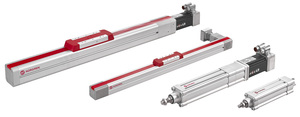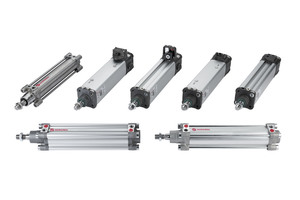
 |
Charlotte Stonestreet
Managing Editor |
| Home> | CONTROLS | >Linear | >Multi axis electric motion options |
| Home> | DRIVES & MOTORS | >Linear Actuators | >Multi axis electric motion options |
| Home> | POWER TRANSMISSION | >Linear | >Multi axis electric motion options |
Editor's Pick
Multi axis electric motion options
09 October 2023
Simon Gass outlines the key application and specification questions engineers should consider when assessing multi axis electric motion control solutions

AUTOMATION PLAYS a vital role across many of today’s industrial applications, offering operational efficiency, accuracy, reliability, repeatability, speed, cost-effectiveness, and improved safety benefits, as well as control and monitoring of machine and manufacturing performance.
Inherently, configurable and flexible, multi axis electric motion systems are utilised across industrial sectors such as material handling, packaging, food production, chemical processing, and pharmaceuticals.
With its wide spectrum of potential solutions, multi axis electric motion has the flexibility to satisfy the often-disparate needs of individual applications, whether as part of an OEM machine build project, or enhancing the efficiencies and output of a busy production line.
Understanding the considerations
For this reason, it is important to correctly identify and specify electric motion solutions based on specific objectives and decide upon a standard or more customised system specification according to the application requirements.
The decision to opt for a pneumatic or multi axis electric motion solution depends upon operator need and the specific challenges of the application such as the operating environment, weight considerations, distance constraints, speed, repeatability and precision, as well energy consumption concerns.
Common application challenges for which multi axis electric motion solutions could be suitable include:
- Challenging operating environments: Environmental conditions play a pivotal role in determining the appropriate specifications for the drive and guide components of a multi-axis electric motion system. Machinery utilised in various applications often faces challenges from contamination and harsh surroundings. In such scenarios, employing linear axes equipped with robust roller guides and toothed belt drives proves exceptionally effective.
- Component weight and loading parameters: The mass of the objects to be moved significantly influences the sizing of the axis system, thereby impacting the overall dimensions of the machine. When dealing with smaller and lighter components, fast and reliable movement is essential. Toothed belt drives offer efficiency in facilitating such requirements.
- Short distance requirements: If short distance travel and highly precise positioning of a workpiece are required, spindle drives offer the best solution. Depending on the application, linear axis can be equipped with trapezoidal spindles, which offer lower prices and self-locking capability, or ball screw spindles which offer better repeatability and longer life.
- Speed and repeatability: The type of application in question determines the speed and the required precision. For simple handling of components for transfer to the next production process, highly dynamic linear units can be used to ensure high output levels.
- Precision and accuracy: The machining of sensitive electrical components or filling in pharmaceutical production may require high-precision applications. For this purpose, the systems used must operate with maximum accuracy. Here, many applications rely on very precise ball screws in combination with rail guides for low to medium loads.
- Energy consumption concerns: A sustainable production process needs to address energy consumption and energy costs. Some manufacturers are replacing pneumatic components with electric linear units, including multi axis capability to support this objective. Due to the comparatively high efficiency and lower energy costs, electric linear units are subsequently generating interest.
Technical support is on hand
Norgren’s collaborative and expert team of application engineers offer in-depth and sector-specific experience, allowing them to quickly identify customer challenges and recommend the correct solution. Through a partnership approach priority identification is speedy and the product solution selection process is rigorous and proven.
To help support OEMs and machine builders navigate the considerations around multi axis electric motion, Norgren has published its latest whitepaper Multi Axis Electric Motion: What to know, what to consider. To download a copy visit the website below.
Simon Gass is product marketing manager at Norgren
Key Points
- Multi axis electric motion solutions complement traditional pneumatic-driven options in movement and positioning
- Demand for cost-efficient customised products is growing, is is the requirement for data insight and system connectivity
- It is important to correctly identify and specify electric motion solutions based on specific objectives
- Tech skills gap hampering recovery
- First consumer testbed for 5G technology
- Website for an automated future
- New sensor can prevent defects in major structures
- Evolving network standards for IIoT
- Cyber security guide first to gather global expertise
- 5G smart factory recognised as 4IR pioneer
- Acute UK cybersecurity talent shortage
- £16 MILLION BOOST FOR UK ROBOTICS
- Cutting edge offshore innovation
- LOW COST ACTUATORS
- CONSTANT LUBRICATION
- Roba-linearstop Gets Dynamic Brake Approval
- Solar Linear Actuator
- Precision, Dynamics & Durability
- YOUR CARRIAGE AWAITS
- Laser Distance Measurement
- SCHAEFFLER DEVELOPS WORLD RECORD BREAKING TANDEM LINEAR ACTUATOR
- Continuous Motion System
- Direct Ballscrew Drive Servo Motors





















